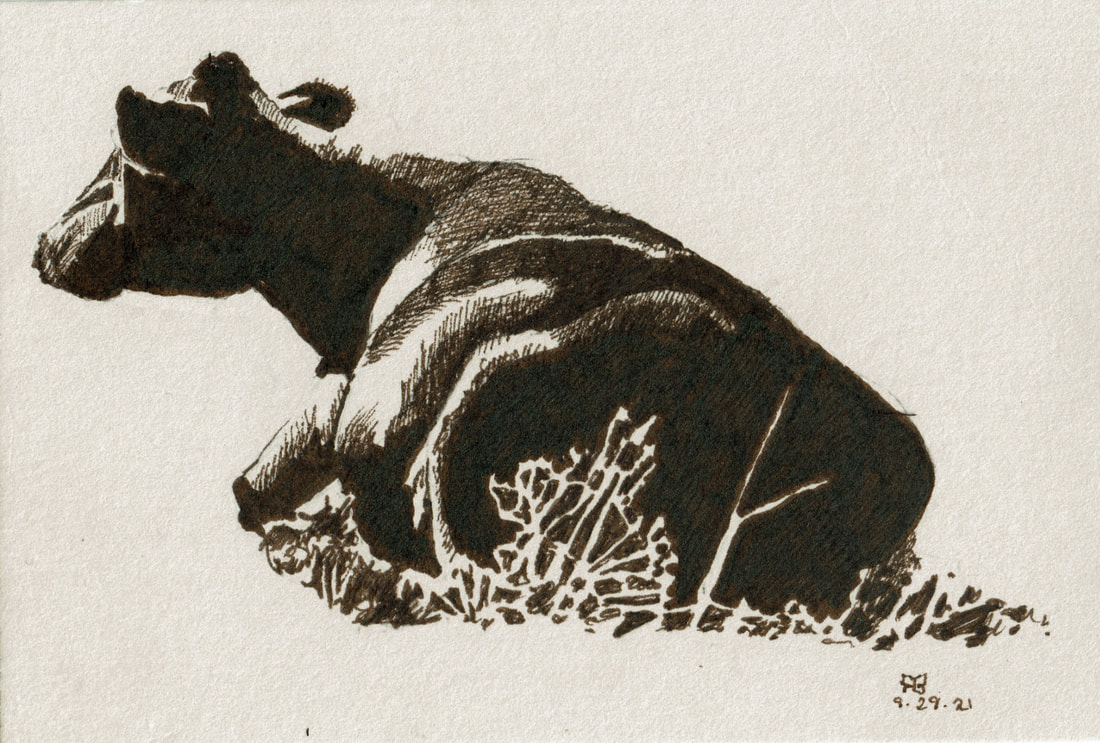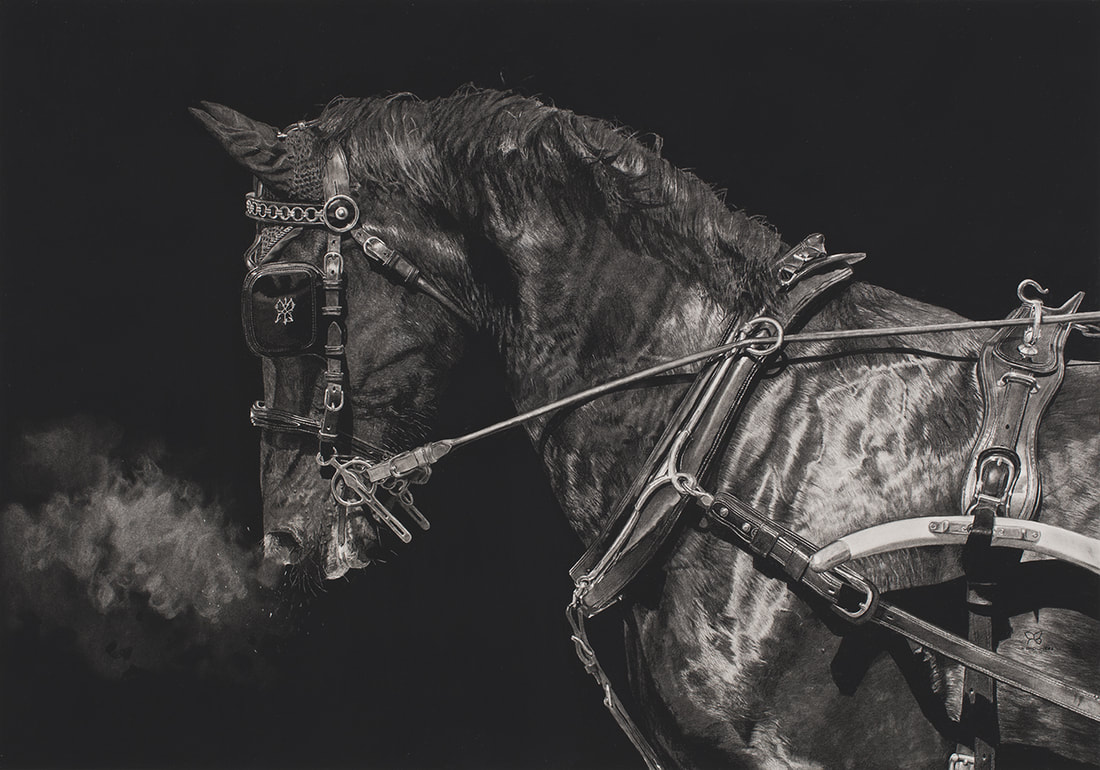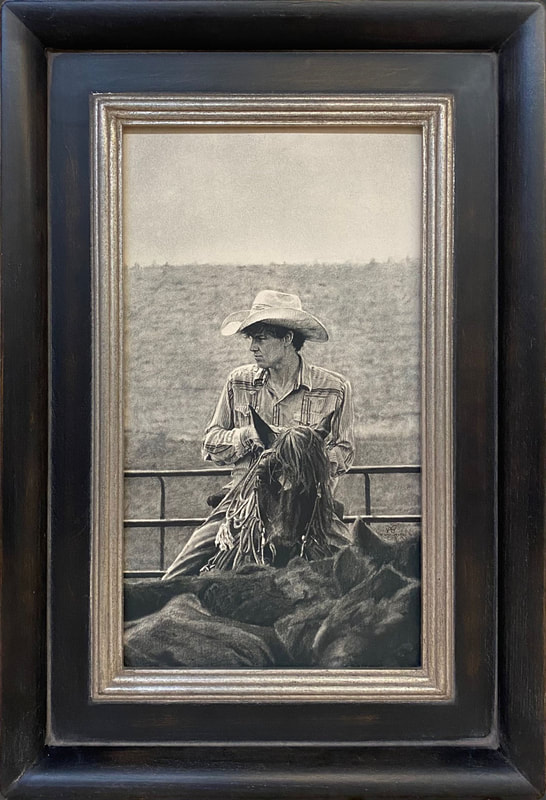At The Ready
30 x 22
2021
Charcoal
Sold
Winner of the 2021 Mountain Oyster Club Art Sale Best of Show and 2021 Nebraskaland Juried Art Show Best of Show
|
"When You Can See The Cows" is the typical cowboy response to the question of "When do we start work in the morning?" which indicates that work starts as soon as there is enough light to discern black cows from the landscape.
Our cattle ranch still does the traditional hot iron branding of 1100 calves every year and we still use horses and ropes to catch the calves. It hasn't changed in format in 100 years. This picture illustrates the earliest dawn and a cowboy preparing his rope to begin work. Traditional cowboy attire is very unique to each person, often accumulated over a lifetime and each piece is intended to last a lifetime. His boots, his spurs, his saddle, his saddle blanket, his chaps, his hat, and his bridle all tell a story about where he has lived and worked. This man has the traditional leather covered tapaderos (the things covering his stirrups and boots) which are usually only worn in the southwest of the United States due to the rough plant life and extreme temperatures. His chaps are too small for him and worn. His blanket is frayed. His saddle is handmade and has a specific basket weave. He tucks his pants into his boots instead of wearing them on the outside which also marks him as being from outside the area where I live. The piece captures a single moment of waiting before work begins in a rapidly dying culture: the life of a real cowboy who still lives every day on a horse. |
Do You Not Perceive It?
30 x 17
2021
Charcoal
Sold
2021
Charcoal
Sold

In this piece I wanted to focus on the structure of the piece more than the details. I really love how it turned out.
I was focusing on a particular kind of day with a particular kind of weather, weather that is recognizable to all who work outside; the low, indistinguishable, soft gray clouds that disperse light so that soft grays all blend together and there are no shadows.
The cowboy stares into the distance in one direction and his horse looks in another. There is a minute of repose before he begins moving his herd of cows. The heavy, wet clouds bring enough wind to lift the horse's tail and merit the cowboy's heavy coat and chaps.
Technically, in this piece I focused on blending mostly dark shades as softly as possible while leaving an untouched line above the hill's edge to show the illumination of day under the cloud cover. I layered the gray horse's hair to illustrate the dapples and I layered the grass to show the differences in ground cover depth.
I was focusing on a particular kind of day with a particular kind of weather, weather that is recognizable to all who work outside; the low, indistinguishable, soft gray clouds that disperse light so that soft grays all blend together and there are no shadows.
The cowboy stares into the distance in one direction and his horse looks in another. There is a minute of repose before he begins moving his herd of cows. The heavy, wet clouds bring enough wind to lift the horse's tail and merit the cowboy's heavy coat and chaps.
Technically, in this piece I focused on blending mostly dark shades as softly as possible while leaving an untouched line above the hill's edge to show the illumination of day under the cloud cover. I layered the gray horse's hair to illustrate the dapples and I layered the grass to show the differences in ground cover depth.
Now My Eyes See You
22 x 29
2021
Charcoal
Sold
Winner of Second Place at the American Plains Artists Juried Show and Sale in 2021
|
The model for this piece is my sister Heidi who, in real life, does personify the idea I am illustrating. Ranch women work hard and struggle with gender roles that are more firmly entrenched than in most cultures in the US. Their lives consist of long hours in the sun and wind, but also the cooking, cleaning, bill paying, and child raising that accompanies being female. The woman in this picture has a college degree, worked harder than most men have ever heard of working, raised five children, and accomplished more in her businesses than most people dream of.
The title of this piece is based on Job 42:5 "My ears had heard of you, but now my eyes have seen you." This, to me, represents the growth I have experienced in the last year artistically and spiritually. I have prayed for God to open my eyes to see the world more clearly and in depth for my artwork; that I would be able to see into the heart of the person I am drawing. I feel my prayer has been answered this year and it is visible in this piece culminating a year of marathon labors. Technically this piece consists of many layers, laying down charcoal, brushing it into the paper, erasing it, adding depth, shine, and texture. The wood grain was particularly interesting. |
So Great a Cloud
27 x 12.75
2021
Sepia Charcoal
Sold
2021
Sepia Charcoal
Sold
|
This piece was a pleasure to do. It had interesting textures, focal lengths, and motion. I learned a few new things that I will use moving forward. Studying how a new medium functions is always so interesting.
The title is based on Hebrews 12:1 "Wherefore seeing we also are compassed about with so great a cloud of witnesses, let us lay aside every weight, and the sin which doth so easily beset us, and let us run with patience the race that is set before us," The verse relates to both the piece and our lives: do everything with purpose because it is significant and yet focus on the eternity which all of us must face. |
Things Unseen
30 x 22
2021
Charcoal
Sold
2021
Charcoal
Sold
|
"Things Unseen" is the pinnacle of my high detail work. It focuses on the intricacies of long, knotted horse hair. The horse is young, has its ears tuned to its rider. The headstall is rough, unlatched, broken. "Things Unseen" as a title has several levels of meaning. At its most shallow level it refers to the efforts and time and practice the artist exerts before achieving skill of this kind. People see this work and ask how someone can be so skilled, but the answer is the unseen thousands of hours of work before this piece. At a deeper level, the title is in reference to the Bible verses from 2 Corinthians 4: 16-18 which refer to current human affliction being nothing when compared to eternal glorification in Jesus Christ. This meaning has spiritual implications, but also to the effort exerted on this specific piece and the achievement at the end. It was a serious challenge to my technical ability and my mental ability; drawing complicated, amorphous hair is very mentally taxing and I had to take a lot of breaks.
This piece took 110 hours to complete. |
Like Willows by the Watercourses
12 x 9
2021
Sepia Charcoal
Sold
2021
Sepia Charcoal
Sold
|
This piece is done in the style of old photography and focuses on differences in focal length and shading. The trees in the background fade away leading you to the possibility of the unseen stream weaving among them.
This piece has a custom frame by Montgomery Framing in Tempe, Az. It was framed with museum quality UV protecting plexiglass. This piece was also featured in the February edition of Western Art Collector Magazine. |
Content to Breathe
19 x 26
2021
Charcoal
Sold
|
The title of this piece is based on Alexander Pope's poem "Ode to Solitude" which I think captures the modern cowboy/rancher/farmer quite well.
Happy the man, whose wish and care A few paternal acres bound, Content to breathe his native air, In his own ground. Whose herds with milk, whose fields with bread, Whose flocks supply him with attire, Whose trees in summer yield him shade, In winter fire. Blest, who can unconcernedly find Hours, days, and years slide soft away, In health of body, peace of mind, Quiet by day, Sound sleep by night; study and ease, Together mixed; sweet recreation; And innocence, which most does please, With meditation. Thus let me live, unseen, unknown; Thus unlamented let me die; Steal from the world, and not a stone Tell where I lie. |
Mere Breath
24 x 34
2021
Charcoal
Sold
2021
Charcoal
Sold











